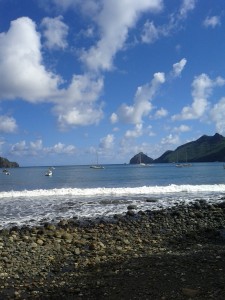 In the past I’ve done quite a lot of solo sailing on Illusion, starting in my first years of ownership, sailing into San Francisco’s inland waterways (1000 miles of diked paths snaking through California’s central valley), then later coastal cruising around New Zealand. But this voyage – from Nuku Hiva (in the Marquesas of French Polynesia) to Hawaii – was my first open-ocean passage alone. Usually I set an anchor each night – this was different: 15 days with no anchoring; two weeks out of reach of land. It sounds dramatic, perhaps, but in other ways it was very similar to previous sailing experiences. And as I was alone on the boat, I didn’t feel the same responsibility or concern for how the others were doing. I could make decisions solely based on my needs. If anyone was going to be sick or get injured or break something, it would be me…
In the past I’ve done quite a lot of solo sailing on Illusion, starting in my first years of ownership, sailing into San Francisco’s inland waterways (1000 miles of diked paths snaking through California’s central valley), then later coastal cruising around New Zealand. But this voyage – from Nuku Hiva (in the Marquesas of French Polynesia) to Hawaii – was my first open-ocean passage alone. Usually I set an anchor each night – this was different: 15 days with no anchoring; two weeks out of reach of land. It sounds dramatic, perhaps, but in other ways it was very similar to previous sailing experiences. And as I was alone on the boat, I didn’t feel the same responsibility or concern for how the others were doing. I could make decisions solely based on my needs. If anyone was going to be sick or get injured or break something, it would be me…
As with most ocean crossings, the days were filled with sky and sea, brief radio check-ins, getting food and trying to get sleep. There are plenty of ocean-crossing sailors who describe it as boring. I wouldn’t say that, but there aren’t necessarily lots of anecdotes to come out of it! The first day proved to be the most action packed so it gives an idea of a busy day at sea:
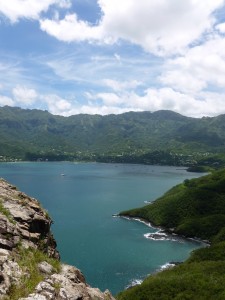 Before setting off
Before setting off
The night before setting sail I was on land longer than usual – saying goodbye to Sara via Google Chat and hoping to calm her concerns about the passage. I’ll admit now that I didn’t share all my thoughts about the potential difficulties, because I didn’t want her to worry about me not using the autopilot – which I had just fixed by purchasing (and waiting for) a new motor from England. I was aware that I may not have enough solar energy input during the trip to manage the energy requirement of the autopilot. After making it back to the boat about 9:30, long after dark, it was time to stow the dingy and its engine. The 8hp Honda engine was the most challenging task to do single-handed since during passages it’s kept hidden away in the main engine room – I rigged a block and tackle system to my swivelling arch arm on Illusion‘s stern and hauled it up off the dingy, swung it around into the cockpit, then lowered it into the engine compartment. Simple work if not challenged with an unusable right arm/shoulder in a very rolly anchorage. After that, my arm was too sore to manage more than bringing the dinghy onto the foredeck. Bedtime was 11pm, late for a place where it gets dark at 6pm!
One long day
I awoke before my alarm (something that was to happen countless times in the next 15 days) at 5:30am and finished tying down the dinghy, repacking the anchor locker, and for good measure, changed the genoa furling line. We measured and bought all new running rigging while in New Zealand, but somehow got the lengths of the furling lines wrong, so neither staysail nor genoa line was long enough to completely furl the sail or have any left over when completely unfurled. I knew that working alone when the wind was blowing I was going to need that extra length, so it made sense to rerig the genoa’s old line. By 7am I was ready to raise the 200 feet (60m) of anchor chain, which only took 20 minutes using the anchor windlass and me helping with a winch handle. I was adrift!
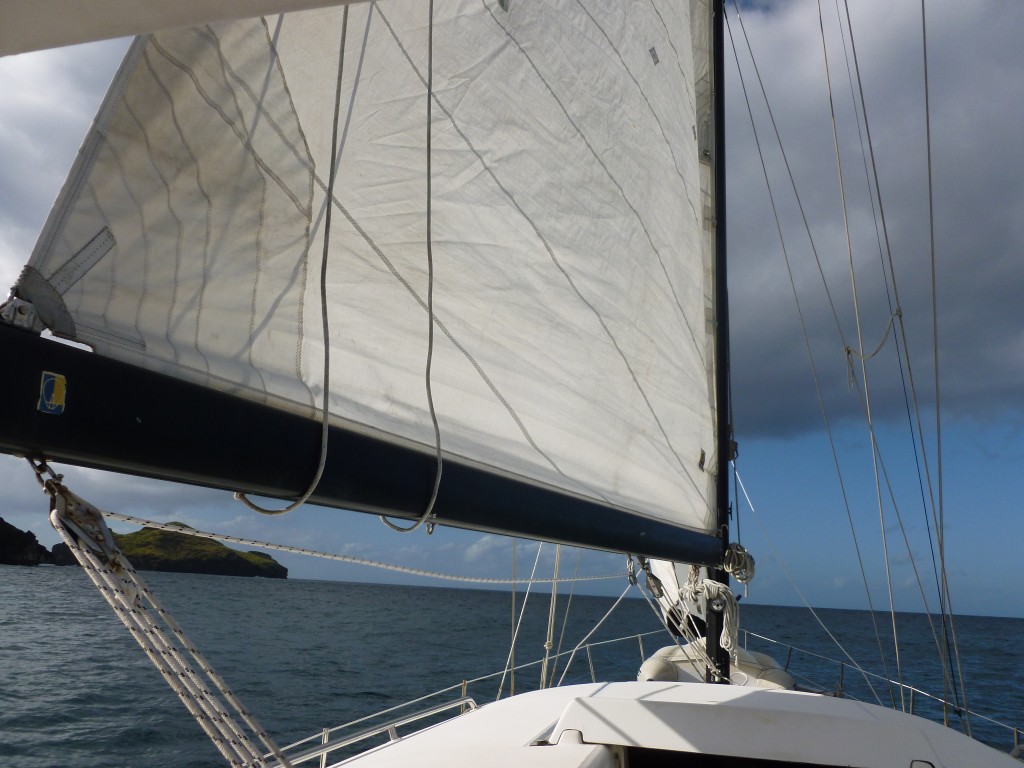 I’d been monitoring the wind conditions in the early mornings, so knew that it would be light winds (easy to raise the anchor), but not windless (easier to avoid drifting into land), but this morning was unusually light wind – and surprisingly from the north, not east. Back in the cockpit, I pulled out the staysail, then steered Illusion on a slow 180° turn toward Taiohae Bay’s exit. Progress was extraordinarily slow, but with the help of a fully raised mainsail, we were out of the bay by 8am. The transition to “outside the bay” was quite dramatic: suddenly there were strong easterly winds with 2-3 meter seas, and the boat was flying downwind at 11 to 13 knots! So it only took 30 minutes to cover the six nautical miles to the southwest corner of Nuku Hiva, where after turning north, I almost immediately encountered the island’s wind shadow – a good chance to reduce the mainsail to its second reef (smallest sail area).
I’d been monitoring the wind conditions in the early mornings, so knew that it would be light winds (easy to raise the anchor), but not windless (easier to avoid drifting into land), but this morning was unusually light wind – and surprisingly from the north, not east. Back in the cockpit, I pulled out the staysail, then steered Illusion on a slow 180° turn toward Taiohae Bay’s exit. Progress was extraordinarily slow, but with the help of a fully raised mainsail, we were out of the bay by 8am. The transition to “outside the bay” was quite dramatic: suddenly there were strong easterly winds with 2-3 meter seas, and the boat was flying downwind at 11 to 13 knots! So it only took 30 minutes to cover the six nautical miles to the southwest corner of Nuku Hiva, where after turning north, I almost immediately encountered the island’s wind shadow – a good chance to reduce the mainsail to its second reef (smallest sail area).
When Illusion and I were last in this area, we encountered the only dolphin “super-pod” I’ve ever witnessed: easily 1,000 dolphins all swimming together in this same large area (around the northwest corner of Nuku Hiva in 1999) – a truly amazing sight! I wasn’t disappointed this time, either. Rather than a super-pod, after gliding slowly north for an hour, I was passed by many separate, normal-sized pods (about 10-15 per pod), probably 40 pods in all – I spent an hour at Illusion‘s bow watching them proceed slowly past, heading north with me in the gentle shadow of the island. I enjoyed it so much that I forgot to take pictures…
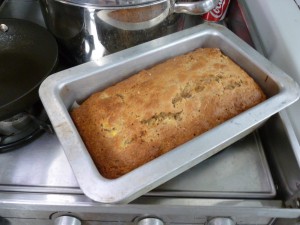
The rest of the three hours in the wind shadow provided a good opportunity to make a salad (canned vegetables and tuna) and bake a canned-vegetable loaf – after almost 6 months of eating almost exclusively canned food, even a little variety is welcome. Soon enough the wind, seas and boat speed came back up to “normal” open-ocean conditions. I decided to hang out in the cockpit for a while, settling onto the cockpit floor behind the wheel, planning to “drive” some and maybe rest as well. Anticipating that I probably wouldn’t have enough electrical energy for the autopilot to run 24 hours a day for the two to three weeks of the passage, I wanted to drive when possible to conserve power. But no more than 10 seconds had gone by before a wave crashed over and soaked me. Watching the barrel-full of water drain out through the lee-side cockpit hole, I decided not to steer, used the last few liters of rain water in a bucket to rinse out my now soaked clothes, and retreated inside. After that, I did the ground-hog thing of popping my head out of the cabin every hour or so to look around for ships.
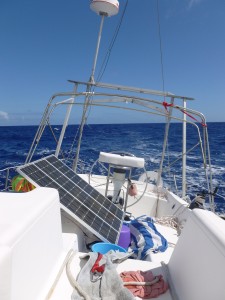
Knowing that the solar panels would perform much better if pointed directly at the sun, I removed them from the top of the arch and gave them a prominent position in the cockpit. Morning and afternoon I would angle them up at the rising or setting sun – I learned years ago in the SF Delta that they produce about three times as much energy in a day with this technique. It served me well, as I was able (at least on this first day, and the remaining sunny ones) to run the autopilot, lights, nav gear and SSB radio with no problem, zooming along at 9-10 knots in warm seas.
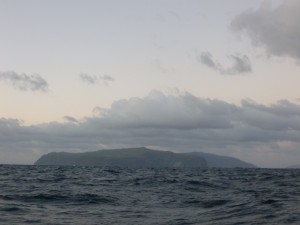 Just before sunset, I passed Eiao, a small, uninhabited, high cliff-edged island – the last land I would see until Hawaii. I’d been told to plan a stop there, it’s an amazing place to visit and is now an ecological reserve; but after almost seven months, I was exhausted with this whole adventure and just wanted to be home – even one more day’s delay felt like too much. But the sunset was amazing: a crisp horizon studded by high cumulus clouds in the distance. Just before checking into the nightly radio net, I went out into the cockpit to see if I could observe the green flash. The sun peeped below the clouds then sank below the horizon. Just after it disappeared, the green appeared for half a second. Illusion rode up on a wave and it briefly reappeared, then stepping up onto the cabin top, I saw it a third time! I’ve seen it many times before, even two flashes once from riding up a wave, but this was the first time I saw three flashes in one setting!
Just before sunset, I passed Eiao, a small, uninhabited, high cliff-edged island – the last land I would see until Hawaii. I’d been told to plan a stop there, it’s an amazing place to visit and is now an ecological reserve; but after almost seven months, I was exhausted with this whole adventure and just wanted to be home – even one more day’s delay felt like too much. But the sunset was amazing: a crisp horizon studded by high cumulus clouds in the distance. Just before checking into the nightly radio net, I went out into the cockpit to see if I could observe the green flash. The sun peeped below the clouds then sank below the horizon. Just after it disappeared, the green appeared for half a second. Illusion rode up on a wave and it briefly reappeared, then stepping up onto the cabin top, I saw it a third time! I’ve seen it many times before, even two flashes once from riding up a wave, but this was the first time I saw three flashes in one setting!
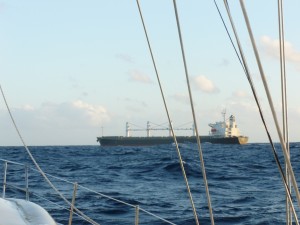
About 5:20am I was up to have a look around and turn off the tri-color navigation light. The AIS alarm sounded! It took me a second to realize the alarm was real and I looked outside to see the Florinda 1 cargo ship about 2.5 nautical miles away and on an oblique collision course (about 30 minutes away). I watched them for 10 minutes or so, then noticed on AIS that they changed course by 10° – now they would pass in front of me. Another half an hour went by before I decided they were close enough for pictures. I tried using DSC (digital selective calling) to reach them and say thanks for changing course; I heard them on a different radio channel, but we never did connect. Eventually, late that afternoon, they vanished over the horizon and I didn’t see another ship until in Hawaiian waters.
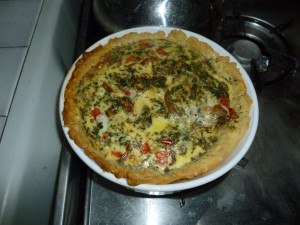
Most of the other days were so uneventful that the salmon quiche I baked was pretty much a highlight! But it is really amazing to be so immersed in nature, the ever present force all around us that is so easy to forget while living a “normal” life in the middle of a city. I had really missed the dolphins, whales, clouds, stars and sunsets while living on land for so many years. Arriving, fifteen days later, into the marina on Oahu, Hawaii, I felt the familiar excitement at reaching land, being safe, having made it. But at the same time, the disappointment that, for now, this was as far as Illusion would get…
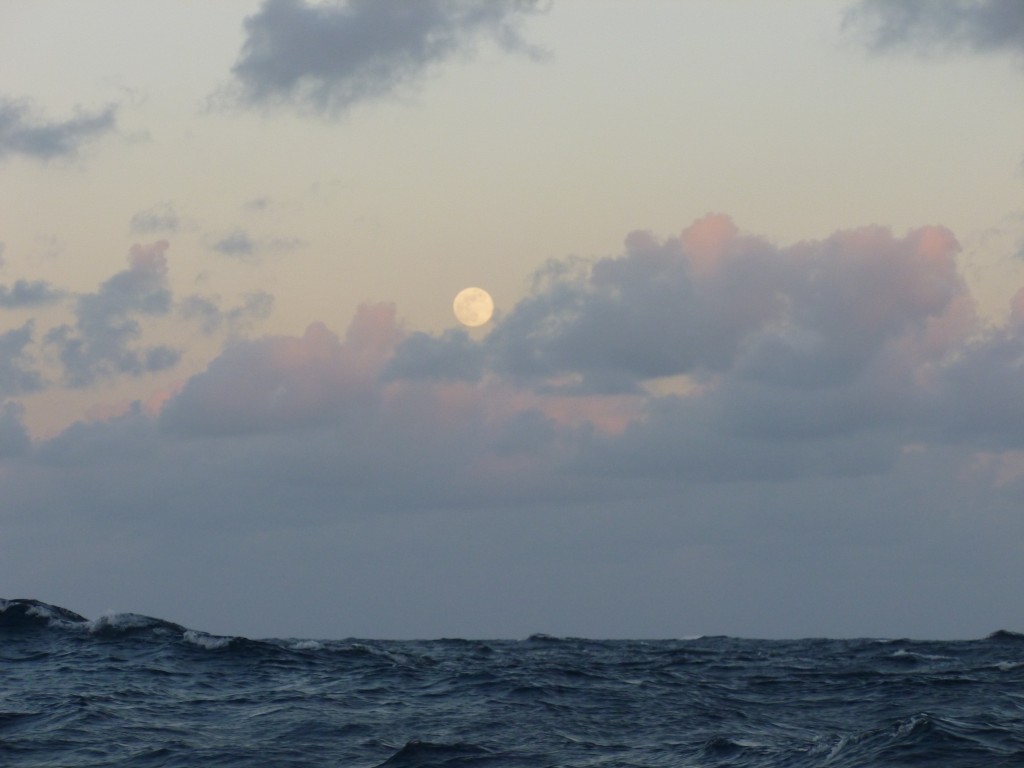
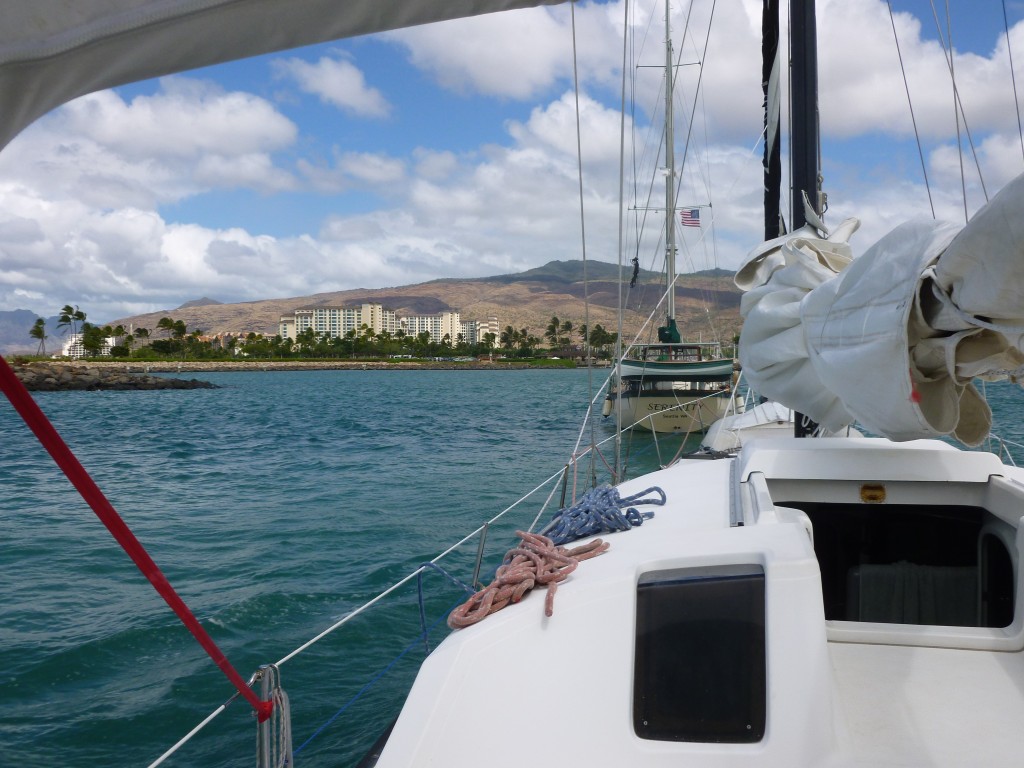
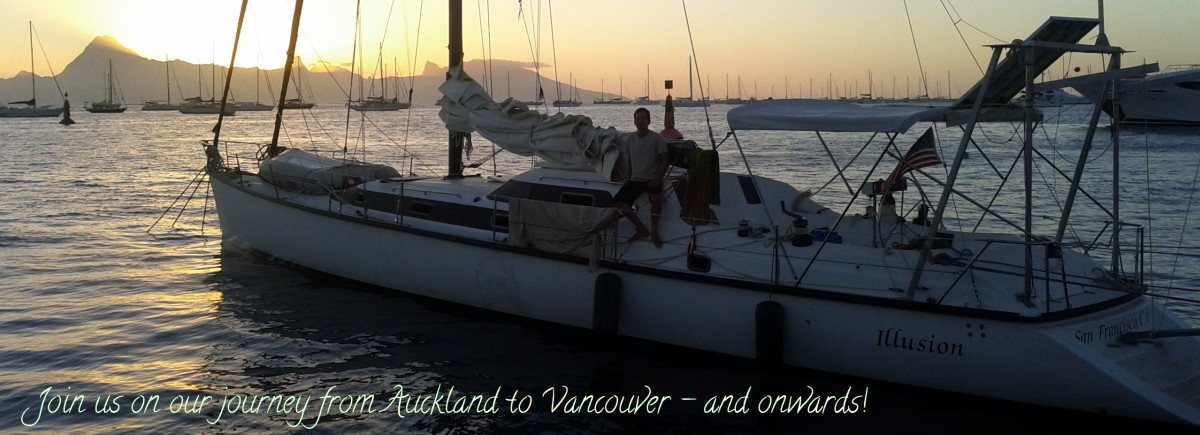
2 thoughts on “Solo sailing: a day in the life”